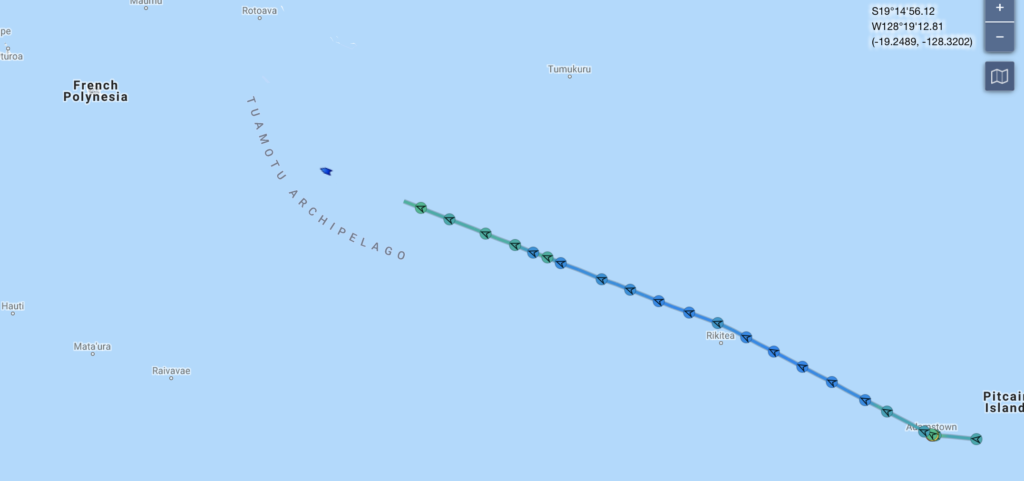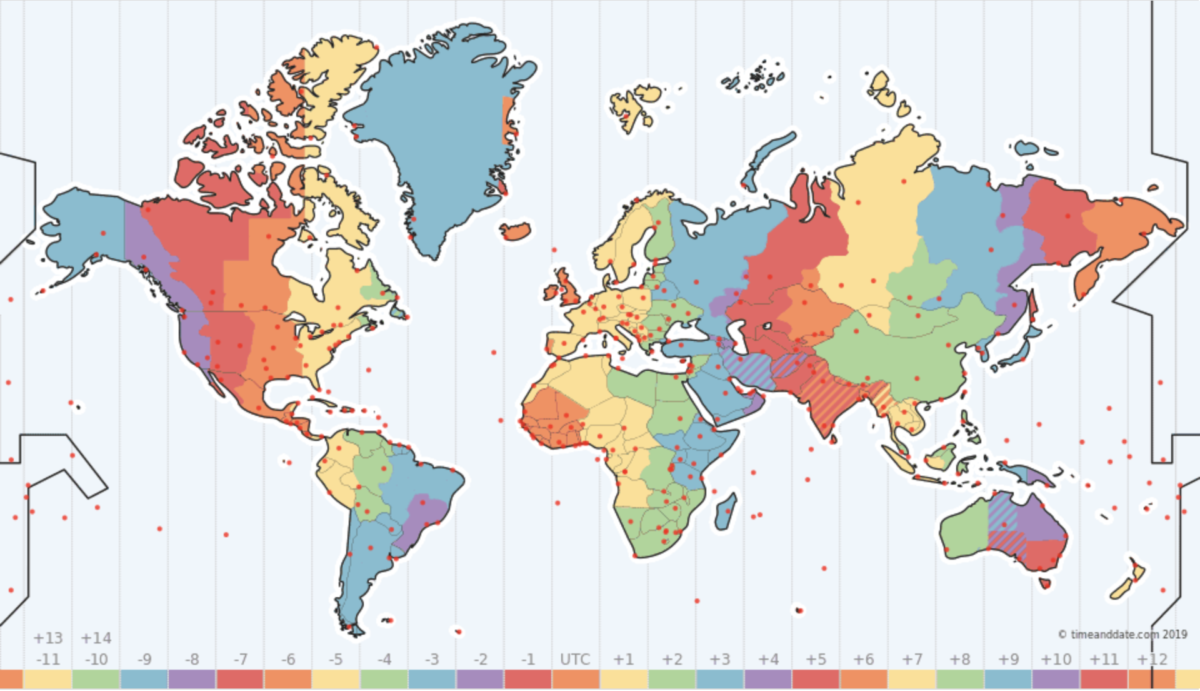Thursday, February 14, 2019 and Friday, February 15, 2019
Where am I?

What time is it?
Aboard ship, it’s always easy to know what day it is. For example, yesterday was Valentine’s Day and today…isn’t. Easy peasy. The sun comes up, the sun goes down, and it’s another day!
Knowing what time it is can be a completely different matter.
You may be reading these words from your home or your place of business. Knowing the time of day there is a very uncomplicated thing because you always know what time zone you’re in. Maybe you need to futz with Daylight Saving Time, but even then you only need adjust every timepiece in the place just twice a year.
My (temporary) home is a ship that moves about 400 miles a day. As a result, it is very easy to lose track of what time it is today because the hour changes depending on where we are, or more likely, where we’re going! Let me give you an example.
Look at the following graphic:

If you look carefully at the border between Perú and Chile you’ll notice that there is a two hour time difference between the two countries. That means as you head south from Perú, the moment you cross into Chile the time is two hours later than it used to be just a second ago!
Time zones are, theoretically, 24 evenly spaced slices on the surface of the earth. If this were actually true, however, the slices would run through the middle of countries, dividing them into time zones that might not accurately reflect local, commercial, or political desires of the affected country. So, time zones are altered (or sometimes completely ignored) by some countries in order to reflect the realities of life in that country. The missing time zone between Perú and Chile, again, is a good example of that.
The ship is like a floating country in regards to time zone observation. It has its own time as determined by the captain and crew, and may (or may not) reflect the actual time zone the ship lies in. A good example of this would be when our ship sailed from Lima, Perú, to Arica, Chile. On the map and as mentioned before, the time changes by two hours as soon as you cross the border. On the ship, however, it is easier on the passengers and crew to manage smaller, one-hour changes instead. So, when we left Lima, the ship set its clocks forward by one hour on the first night at sea, then forward again another hour in time to reach Arica and have the ship’s clocks align with the clocks ashore.
On this trip, so far, we have had a number of these one-hour time changes and that is why it has become difficult to know what time it is if one has not been keeping up with the announcements and setting their clocks and watches accordingly. Here is a list of the time changes we’ve experienced on board this ship that were influenced not only by time zones but by the local time at approaching destinations.
| Date | Set clocks | by | leaving | approaching |
| 2/3 | forward | 1hr | Lima, Perú | |
| 2/4 | forward | 1hr | Arica, Chile | |
| 2/6 | back | 1hr | Arica, Chile | |
| 2/9 | back | 1hr | Easter Island | |
| 2/11 | back | 1hr | Easter Island | |
| 2/12 | back | 1hr | ||
| 2/13 | back | 1hr | Pitcairn Island | |
| 2/14 | back | 1hr | Pitcairn Island | |
| 2/15 | back | 1hr | Papeete, Tahiti |
So that is nine time changes in twelve days! Sometimes setting the clock forward, but mostly back. Can you start to see why I’m not always sure what the ship’s time is? In the mornings, one of the first things I do is to consult the ships web portal to see what time is displayed there. Then, I go around and set the time on all of the digital toys that I’ve brought with me. Now, you may be telling yourself, “That’s silly! I’ve driven from Arizona to California and my phone automatically deals with the time zone change for me.” Well, that is very likely true because cellular networks at home send the current local time to everything on their networks, and they do it 24 hours a day. But, here on the ship, even though there is a “Cellular At Sea” cell network, it does not broadcast the ship’s time, so my phone has no clue that the ship’s time has changed. Neither does my iPad, or my computer. So, that’s one of my jobs to do (seemingly) every day shortly after I wake up.
But, who cares?

Now that I’ve let off some steam about all this clock setting, let me point out some of the advantages of these time zone changes that I’ve experienced, so far.
Since I’m never quite sure when to adjust my clocks (at night before bed or maybe in the morning when I get up?), I’ve started to just go to sleep when I’m tired and get up when I’m through sleeping. This feels more natural to me and because I’m so clock-driven in “real” life (and I’ll bet you are, too) it feels more relaxed to just rely on the sun and forget what the clock might say.
If one cannot get the clock out of one’s mind, then here is another way to look at all of the “1 hour back” adjustments: it’s like having a 25-hour day, almost every day! What could you accomplish if you had 25-hour days? I’ve been investing that extra hour in my sleep time. I can now sleep for 10 hours, but according to the clocks, I’ve only been asleep for nine! I know that, for the first time in a long time, I feel completely caught up on sleep. I have absolutely no sleep deficit at this time, and it feels amazing!
So, because we are heading generally west, I should still pick up a few more of these 25-hour days, and I’m OK with that even if I have a new clock-setting chore each morning. Still, a big question looms in my mind and I have no idea how it will be resolved:
What happens when I cross the International Date Line?
Company for dinner
A few friends dropped in for dinner last night. This is just one video I took. Over the course of my dinner I saw five large pods of dolphins. Even the wait staff said that they had never seen so much dolphin activity in a single evening. I see dolphins all the time in Puerto Peñasco, but I never get tired of watching their graceful beauty.
Money Report
I’m all set for shopping in Papeete, Moorea, and Bora Bora ‘cause I’ve got some French Polynesian Francs!

500 French Polynesian Francs 
The other side
But, that’s a story best left until tomorrow!
G’night!

